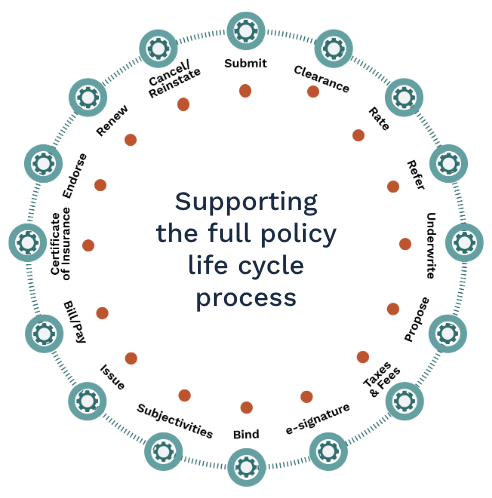Digital transformation isn’t just a buzzword for P&C insurers—it’s a business necessity. But turning strategy into action isn’t easy. At Solartis, we’ve seen firsthand how carriers and MGAs can accelerate modernization by tackling these five common challenges head-on.
As our CEO, Nick Richardson, puts it:
“Digital transformation isn’t just about technology. It’s about building a flexible foundation that lets you respond faster to market changes and customer needs. That starts with breaking down the barriers that slow you down.”
To stay ahead in today's competitive landscape companies must adopt digital transformation for P&C insurance. That means embracing technology to meet evolving customer demands and adapt to the ever-changing market dynamics.
The numerous advantages of embracing insurance digital transformation begs the question: why have P&C insurers been hesitant to adopt these changes? The answer lies in the challenges that digital transformation presents in the insurance industry.
Overcoming 5 Common Roadblocks to Digital Transformation in P&C Insurance
1. Legacy Technology That Slows You Down
Old systems weren’t designed for today’s speed or complexity. They’re hard to update, expensive to maintain, and often disconnected from modern digital experiences.
So how can P&C insurers modernize legacy technology?
The Solution: Leading insurance carriers are shifting away from rigid, monolithic systems toward cloud-native, microservice-enabled platforms that offer the flexibility and speed today’s market demands. These modern architectures support continuous improvement, rapid product configuration, and faster speed-to-market.
Rather than ripping and replacing an entire core system, P&C insurers can take a modular, API-first approach—targeting high-impact areas like quote and bind, endorsements, or billing. This allows teams to modernize incrementally, integrate with both legacy and new systems, and deliver real business value at every step.
Tip: Choose vendors with deep P&C domain expertise and prebuilt insurance functionality, so you're not forced to reinvent core capabilities from scratch.
2. Competing Priorities and Limited Resources
Even with the right insurance technology in place, it’s tough to prioritize innovation when you’re busy keeping the lights on. P&C insurance carriers often find themselves caught between regulatory demands, growth initiatives, and operational fire drills.
How can P&C insurers overcome limited resources and too many priorities?
The Solution: A modular approach can allow teams to focus on specific, high-impact improvements that deliver fast ROI.
Microservice-enabled platforms like Solartis Insure let insurers break large, multi-year projects into smaller, sprint-based improvements. Leverage our expertise and prebuilt components to co-create solutions instead of trying to build everything in-house.
3. IT Talent Shortages
Hiring and retaining skilled tech professionals is harder than ever. Whether you’re modernizing core systems or building new digital products, talent constraints can slow you down.
How can P&C insurers address the insurance IT talent shortage?
The Solution: Empower your business teams with low-code or no-code tools that reduce reliance on developers. Upskill internal teams with modern digital tools and supplement with managed services when needed.
Low-code toolkits like Solartis Builder empower business analysts and product managers to do more—without always relying on developers. For example, by using a tool like Solartis Builder, an underwriting team could launch a new small commercial product workflow without waiting six months for IT bandwidth.
Key Takeaway: Low-code policy administration systems help insurers deliver digital products faster, even with limited technical staff.
4. Cultural Resistance to Change
Insurance technology is only as effective as the people who use it. If teams aren’t ready for digital transformation—or aren’t part of the process—adoption suffers.
How can P&C insurers encourage employees that resist technology change?
The Solution: Successful digital transformation in P&C requires a people-first strategy with strong change management and intuitive tools. Involving users early, offering intuitive tools, and focusing on real business value makes transformation something teams lean into, not resist.
Tip: Establish champions inside underwriting, claims, and operations who can drive peer adoption.
5. Siloed and Inconsistent Data
You can’t innovate if your data is stuck in spreadsheets or disconnected systems. Clean, consistent, accessible data is the fuel for automation, analytics, and smarter decision-making.
How can insurers fix siloed and inconsistent data in P&C?
One way to future-proof your insurance system is with modern, microservice-enabled, and market-tested policy administration software. Solartis helps P&C insurers build reliable data pipelines across the insurance policy lifecycle.

Solartis: Built for Today’s P&C Insurance Challenges
Solartis Insure is a cloud-native, microservices-based policy administration platform with over 150 microservices that support every step of the policy lifecycle. Combined with Solartis Builder—our low-code configuration toolkit—insurers can launch and update products faster while keeping control in the hands of both business and technical teams.
“Solartis Builder is a game changer,” says one of our clients. “We can make changes quickly, test instantly, and go live with confidence—all without waiting weeks for dev time.”
💡 We’re also integrating AI enhancements into Solartis Builder and the broader platform to streamline configuration, improve accuracy, and surface deeper insights. These features aren’t replacing your team—they’re enabling them to do their best work, faster.
Let’s talk
Ready to move past the blockers and build your future state? Whether you’re exploring your first microservice or planning a full modernization, Solartis is here to help you move forward—confidently.




